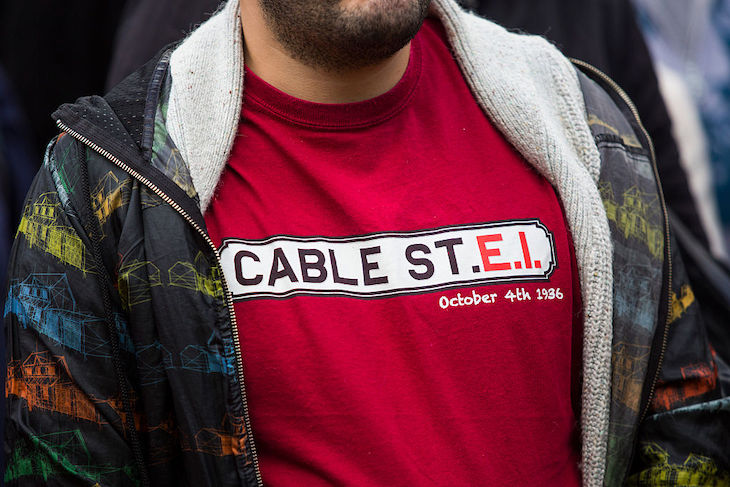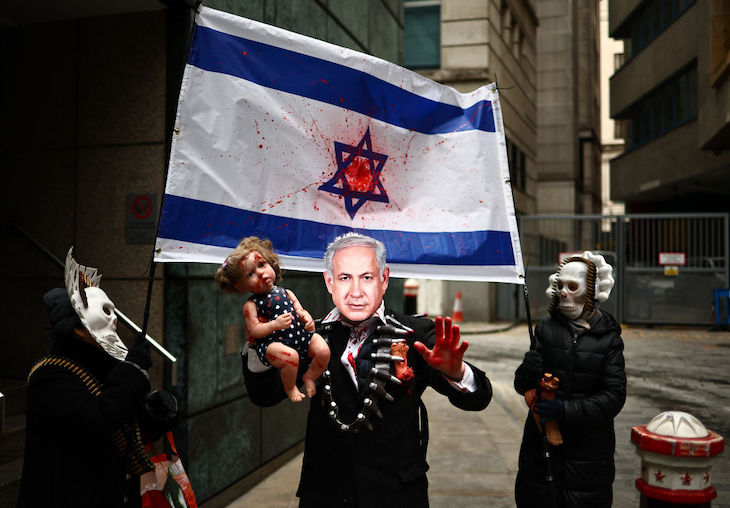There are some among the tens of thousands who march through London each week who genuinely seek peace in Gaza. There are others who march because they are anti-Semites. They hate Jews and want them eradicated. They sing songs about genocide and they brandish Swastikas and sport stickers celebrating the massacre of 1,200 Jewish men, women and children by Hamas terrorists on October 7th last year.
This is not the first time that anti-Semites have paraded their bigotry through London. But the difference between now and 1936, when Oswald Mosley led his black-shirted British Union of Fascists through the capital’s streets in what came to be known as the ‘Battle of Cable Street’, is the apathy today of ordinary Londoners.
This is not the first time that anti-Semites have paraded their bigotry through London
When Mosley assembled his fascists on Royal Mint Street on the morning of Sunday, 4 October, 1936, thousands of counter-demonstrators had already gathered. The Manchester Guardian reported: ‘Great crowds, booing, singing, and shouting “Rats,” were held back by strong forces of police. The crowds rapidly became more noisy and more demonstrative, and reinforcements of police were summoned by a police wireless car.’
Some of the crowd were trade unionists, some communists and some were from London’s thriving East End Jewish community. But many were just ordinary Londoners (and from elsewhere across Britain), there to make clear to Mosley and his fascists that they weren’t welcome.
There were 84 arrests as the police and counter-demonstrators clashed, and while the Guardian didn’t condone the disorder, the paper understood the anger of Londoners at the ‘anti-Semite campaign in the East End, and the tales of Fascist outrages on Jews’. Reg Weston, who was among the crowd, recalled years later:
‘There was a quarter to half a million people in the East End streets that Sunday. Many of them were Jews…but it was numbered in tens, not hundreds, of thousands. The packed crowds that day consisted of many thousands of non-Jewish Londoners.’

Where are these Londoners today? Why aren’t decent Britons protesting peacefully but volubly against the anti-Semitic element within the Saturday crowds, those who openly support Hamas and the Houthi insurgents in Yemen, who have been attacking British and other western vessels this year? Why are Socialists and Communists, so prominent in running the fascists out of town in 1936, now marching arm in arm with anti-Semites?
In 2010, the Socialist Worker interviewed two of the last participants of the ‘Battle of Cable Street’ in a justifiably proud reminisce about how the left faced down fascism in 1936. One was Alice Hitchen who was 17 at the time.
‘By 1936 I was aware of what was going on in Germany and at resentment here to the Jews,’ she said. ‘I wanted to be part of the resistance to that.’ Today, the Socialist Worker seemingly exhorts its members to march for Palestine through London, a city that, in the words of one Israeli government minister, is the ‘most anti-Semitic in the west’.
In 1936, the police initially allowed Mosley’s march to go ahead. The reinforcements drafted in were to contain the vast crowds shouting abuse at the fascists. It soon became clear to Sir Philip Game, the Commissioner of Police, that to permit the march to proceed would risk serious public disorder. After consulting Mosley, the procession through the East End was cancelled, and instead the fascists were escorted by the police along the Embankment to the Temple Station, where they dispersed. That is how to stand up to bigots. To noisily – but non-violently – display one’s opposition to their hatred.
Three years earlier in another European capital city anti-Semites had aggressively demonstrated against Jews. As one American newspaper reported from Berlin on 2 April, 1933, ‘brown-shirted Nazis swarmed through the thoroughfares carrying buckets of paints, with which they splashed identifying signs on every shop run by a Jew’. The Nazi Women’s Federation declared in a statement that ‘The Jew must forever be eliminated from our people and our state’.
A nationwide boycott had been organised on 1 April of all Jewish stores, but many Germans ignored it and shopped as normal. In Berlin, the weather was balmy and most people took no notice of the Nazis’ incitement to hate because they were ‘in picnic mood’. This passivity, which turned into naivety, was swiftly and brutally exploited by the Nazis.
It is the spirit of Cable Street that Londoners should summon up today
One of the Cable Street veterans who shared his recollections with the Socialist Worker in 2010 was Max Levitas, then a trade unionist. He explained that he had protested against Mosley because he was scapegoating Britain’s Jews. According to Levitas, they had to persuade the Jewish Board of Deputies to be more resolute because the Board had ‘advised Jewish people to stay at home and not to participate. We argued within the synagogues to get people on our side and we agitated inside the factories.’
It is the spirit of Cable Street that Londoners should summon up today. The anti-Semites have the run of the streets because no one is standing up to them. The police’s passivity is a national disgrace, but so is the indifference of ordinary Londoners. They have allowed their city to be taken over by hatred.
Imagine if Mosley and his fascists had encountered similar indifference in 1936? They too would have continued to march, becoming bolder with each passing week.
The ‘Battle of Cable Street’ has been mythologised to a degree; it wasn’t a ‘battle’, it was more a series of short scuffles between police and counter-demonstrators that took place in Cable Street and elsewhere. Considering the vast numbers of anti-fascists on the streets that October day, it was an impressively peaceful protest. They are the most effective form of protests and it is what London needs now before the city’s Jews are chased out of town for good.







Comments